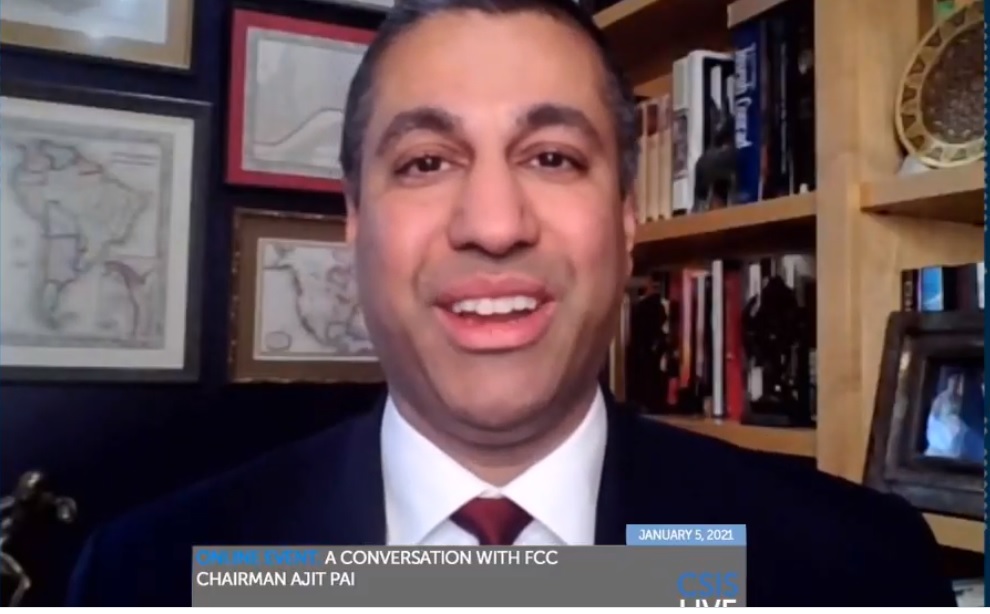FCC Chairman Ajit Pai Talks Up Using 'Hard' Power to Combat Network Threats
Draws distinction between his approach to China and that of his predecessor

FCC chairman Ajit Pai drew a sharp distinction between how the previous Democratic administration treated China and the current one when it comes to communications equipment and networks.
Also Read: FCC Makes Huawei Threat Designation Official
That came in remarks at "A Conversation with FCC Chairman Ajit Pai" web event at the Center for Strategic and International Studies Tuesday (Jan. 5), which were billed as something of a "victory lap" as the chairman winds down his tenure.
Pai said the government under President Obama welcomed the rise of a "stable, prosperous and peaceful" China, suggesting the U.S. and China could work together, while the FCC under then-chairman Tom Wheeler allowed federal subsidies to be used to purchase equipment from "virtually any company," including Huawei and ZTE.
Pai suggested that was a 'naïve' approach filled with "aspirational talk."
By contrast, Pai said, the Trump administration and the FCC recognized the serious challenges China represented, and took the "hard" action to, among other things, rip and replace suspect tech from U.S. networks and exclude suspect companies from U.S. network connections.
Also Read: FCC Denies ZTE Appeal
Multichannel Newsletter
The smarter way to stay on top of the multichannel video marketplace. Sign up below.
Those challenges include a "disturbing and growing pattern of behavior," like Zoom allegedly shutting down an online memorial service for the victims of the Tiananmen Square protest and the concealment of China's role in COVID-19, per Pai.
Pai said he had learned back in a Harvard class about governments wielding both hard and soft power, but did not anticipate that his job would eventually entail employing that lesson, such as identifying threats -- like Huawei and ZTE -- and taking strong action. Both he said have been the hallmarks of his tenure, which is coming to a close Jan. 20.
Pai said that the international tide has turned toward the U.S. position on 5G security, citing countries including Greece, Sweden, the Czech Republic, Poland, Latvia and Denmark, as well as the UK's decision last July to reverse course and remove suspect tech from its networks. "The momentum is unmistakable and unmistakably positive," he said.
Following his remarks, Pai was interviewed remotely by CSIS CEO John Hamre.
Hamre said the reason Huawei tech was used is that the U.S. did not have a comparable supplier. Pai said he thought its success was also due to Huawei stealing intellectual property from the U.S. He said now the issue is more that China is subsidizing Huawei, which gives it a leg up, with its bids sometimes 30% to 70% lower than competitors.
He said that there was no question that Huawei was in a position of strength in a limited market. He said that open RAN technology could allow the U.S. to break that consolidation advantage for Huawei.
Asked if there had been a market failure that prevented the U.S. from being competitive, Pai said there were companies like Nortel and Lucent a couple of decades ago, but unable to get similar returns of a Huawei, it was tough to stay in business as a non-subsidized competitor going up against someone "flooding the zone."
Hamre agreed that competing against state capital is a formidable thing. But he said China got a march on U.S. companies that weren't producing products for the market.
Asked about the debate over the Section 230 immunity provision from civil suits for social media platforms' moderation of third-party content, Pai reiterated that the FCC should think about how that should be interpreted. He said he would "see where it goes," but did not think the issue was going away. He has also said that he believes the FCC has the authority, and the competence, to look at the section.
Hamre said he did not think the FCC would wind up being the arbiter of a final decision on the section.
Contributing editor John Eggerton has been an editor and/or writer on media regulation, legislation and policy for over four decades, including covering the FCC, FTC, Congress, the major media trade associations, and the federal courts. In addition to Multichannel News and Broadcasting + Cable, his work has appeared in Radio World, TV Technology, TV Fax, This Week in Consumer Electronics, Variety and the Encyclopedia Britannica.

